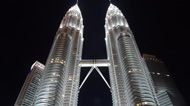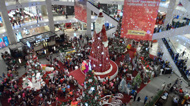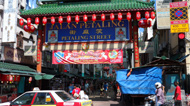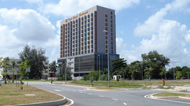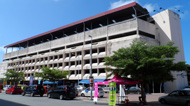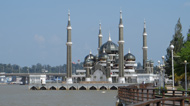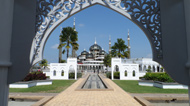 |
Kuala Lumpur is the biggest town in Malaysia and the capital of the Federation. Inside Malaysia the name is often shortened with KL. Recently the government's offices have been moved to Putrajaya, but the residence of the head of state (Yang de-Pertuan Agong), the Parliament and the judicial power have all their seat in Kuala Lumpur. KL is one of the three Federal Territories of Malaysia and an enclave in the Selangor ' state. The main airport of the country is Kuala Lumpur (or KLIA).
The town has been founded in 1857 at the convergence of the rivers Gombak and Kelang, and in Malay language the name means "muddy convergence". The settlement started prospering when Raja Abdullah, a member of the royal family of Selangor, opened the Kelang valley to mineral researches. With the growth of the town, the United Kingdom which dominated the Malaysia of that period appointed a representative (called the Captain of the Chinese) to manage the settlement. The first one was Hiu Siew, but it was the third captain, Yap Ah Loy, that the town enlarged to become the most important in Selangor. In this phase, Kuala Lumpur was in the centre of the Selangor civil war and was devastated, but later it was rebuilt by Yap and ripopulated with Chinese miners coming from other zones of the state. It was in 1880 that the town became the capital of Selangor and in 1896 of the Federated States of Malaysia. During the Second world war the forces of the Japanese empire invaded and occupied the town for a short period in 1942. After the indipendence in 1957 (in Malay merdeka, from which the name of the main square), Kuala Lumpur was chosen as capital of the Federation of Malaysia in 1963. In 1974 the town was separated from Selangor to become a Federal Territory. The eighties and nineties represented the economic and building boom, but did not completely cancel the past. Still nowadays the 1.6 million inhabitants in Kuala Lumpur, or as it is generally called KL, proudly show the cultural and traditional differences of Malay, Chinese and Indian cultures, that nevertheless coexist in a more peaceful way than in other realities.
The attractions not to be lost are the Petronas Towers (452 meters) that represent the symbol of the town and are still today the highest twin towers in the world. The tower of Kuala Lumpur is better known by the local population as "KL tower" and is located in the centre of the Malay capital, in the so called "Golden Triangle", not far from Bukit Bintang and from the Twin towers, of more recent contruction. The tower was commenced in the 4th of Oktober 1991 and was completed in 1995, and is considered as the 7th highest tower in the world, with its total height of 421 meters, antenna included.
It was built on the hill called Bukit Nanas, in three different phases: 1) the achievement of the foundations; 2) the achievement of the basement, during which were poured 50.000 sq. meters of cement in 31 hours - at that time a rekord for the Malay building industry; 3) the last phase was the construction of the today's structure of the tower, also carried out in record time of 8 months.
The tower shelters in its interior an observatory of the lunar phases, called Falak, which announces every year the beginning of the Ramadan, the muslim fast holiday of one month (the muslim calendar is of moon type). The visitors can go to the panoramic floor on the top till late in the evening and dine in the rotating panoramic restaurant, booking at least one day before. The mosque Masjid Jamek, built in 1909 on the confluence between the rivers Gombak and Klang, flanked with palms, in the zone of Little India, is characterized of a wonderful hindo-muslim design and is one of the must ancient mosques in town. The Central Market in bazar style was opened in 1936. A modern restoration has allowed to join many stalls of handicraft. There are sculptures, silk and masks with fresh products and the historical inheritance of this old market in the centre of the town. The Lake Gardens, where jogging, picnic lovers and couples hand in hand like to go, 92 hectars of size, located on an artificial lake on the west side of the Colonial District. The parc shelters the zone of the birds, the orchids' garden, the butterfly park and the insect museum. Out of the town, the Batu Caves are holy limestone caves, in Selangor, 400 million-year old and they represent the holiest hindu place outside India. Centre of interest of the Thaipusam Festival, where millions of pilgrims climb the 272 steps of Batu Caves till the top of the hill every year. In town you can move by monorail (RM 1.20 > 2.40), by metro or by taxi (RM 3 initial tarif for ordinary taxi, RM 6 for luxury taxi). To go from the Concorde hotel to the central station the average price is 10/15 RM by regular taxi. To fly to different destinations in Asia there is Air Asia, a low fare company. All flights leave from KLIA2, near the international KL Airport. A non-stop bus service from KL sentral connects KLIA2: buses leave every half hour, 00.00 and 00.30, and cost RM 10 per person/1h (www.skybus.com.my); on line the ticket costs 8,50 RM. Furthermore, there is also a bus connection between KLIA2 and KLIA which costs 1,50 RM with a departure every half hour.
Very important: In KL there is a free bus for turists that takes you around from 09.00 a.m. till 11.00 p.m. There are three different lines. Ask at the reception of your hotel.
Concorde hotel****
*****
KUALA TERENGGANU
Kuala Terengganu is a town in Malaysia, capital city in the state of Terengganu. Located on the east coast of peninsular Malaysia, Terengganu is the departure point for a holiday in the near islands, located on the malaysian east coast.
The most interesting sites are first af all the Crystal Mosque: a monumental holy place made of steel and crystal, built on the river. It can be visited, except during the prayers, if the clothing conditions are adequate. Shorts or vests are not allowed. Turists are very well welcomed. If you use the taxi to go there it is better to let it wait because there are no taxis down there. Yet, it is possible to use the Wooden Shuttle bus which leaves from the bus station in town and in 20 minutes arrives at the mosque. Inside the bus the interior is made of wood and the service is free, put at the disposal of turists by the local turism office.
Another place to be visited is the Pasar Payang market, always very crowded, with all kinds of fruits and vegetables, where the fragrances of curry and ginger mix with smell of durian and dry fish. On the first floor, on the contrary, there are shops that sell batik. The evening, many restaurants prepare fish along the seafront with a very cheap price. The place is simple, but the food is very tasteful.
The airport in KT is about 10 Km. far away from the town center. From the airport to the center there is a flat rate of 30 MYR. All taxis are without taximeter, and it is always necessary to agree about the fare.
Cambio del 16 dicembre 2014: 1 € = 4,33 MYR
Cambio del 21 gennaio 2015: 1 € = 4,17 MYR
Differenza oraria con l'Italia: + 7 ore (orario solare)

